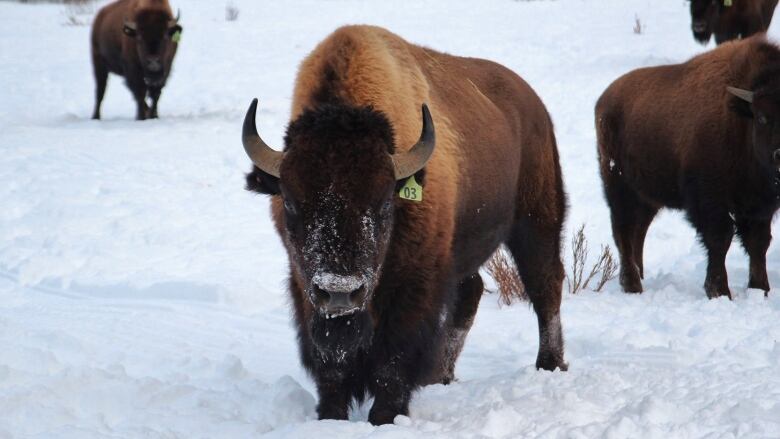Banff bison to roam free this summer in park for first time in more than a century
'They are very calm, they seem at home,' project manager says

Theherd of 16 bison relocated from Elk Island Park to a remote 45-acre enclosure in Banff National Parkseems to be thriving at the one-year anniversary of the project. Now, the animals are getting ready to be released into the wild this summer.
"It's been great to see the herd really fit in. They are very calm, they seem at home," project manager Karsten Heuer of Parks Canada told CBC News on Wednesday.
Sixteen bison were reintroduced to the area last February by Parks Canada after disappearing from Banffbefore the national park was created in 1885.
While many remember what Parks Canada calls a "display herd" of bison housed in a paddock near the Banff townsite until 1997, this herd represents a return to wild animals.
There were six bulls and 10 females moved to the enclosure last February.All ten of those females had calves last spring, bringing the total herd to 26.
- Banff bison herd bolstered by 10 new calves
- Wild bison calves born in Banff National Park 'a huge step' to reintroduction
- Wild bison roam Banff National Park for 1st time in more than century
"We are hoping we will have about 30 in the herd when we release them in the larger area of the back country of Banff National Park this summer," Heuer said.
For tourists hoping to see the animals pre-release, finding their penned area is no easy task, which is how Parks Canada likes it.
"Right now, where we have them, it's a two-day trip, by foot, horseback or ski, to get in and out from the nearest road or trailhead," Heuer said.
"On a nine-day shift, we are spending four of those days getting back and forth as we are caring for the bison. Like any other wildlife, their movements can be unpredictable. Just like how people want to come to Banff and see a bear, some people do and some people don't."

Heuer said the fact that the herd's females were pregnant before the reintroductionis a positive thing for the overall project.
"We wanted them to calve in their new home before we fully release them. That's really important to anchor the animals to this new place, to maximize the chances they will adopt it as their new home."
The multi-year project is about observation, especially after they are released, and understanding.
"We will be monitoring them fairly intensively for the initial few years. After five years, we'll hit the pause button and look at how it's all going. Then we start setting population goals based on what we've learned," he said.
So far, predators have shown only a curiosity to their new neighbours, Heuer said.

"Predators have always been in that area. We've had wolves come right up to the edge of the pasture where the bison are contained. Grizzly bears feeding naturally on the roots and grass on the surrounding slopes within view of the bison, as they would have pre-bison," he said.
"There's been no evidence of anything trying to dig or push its way into the pasture that they bison are currently fenced in."
The release program, just months away, is on track.
"Once we open the gates sometime this summer, it's the ground rules of the wild. If a wolf pack decides they want to take one down, then that's nature. I think it will take some time though," Heuer said.
"A bison is a pretty formidable animal so it will be interesting to see how it evolves."
You can follow the project here.
With files from Elizabeth Snaddon












_(720p).jpg)


 OFFICIAL HD MUSIC VIDEO.jpg)
.jpg)



























































































